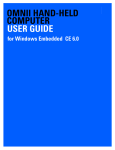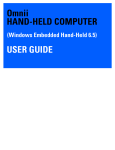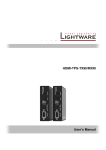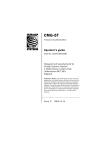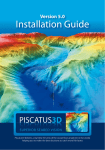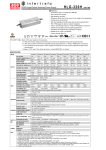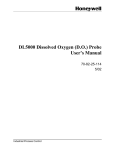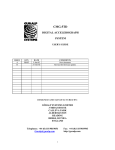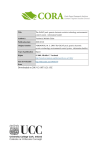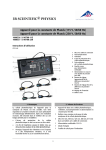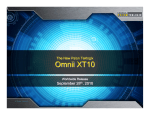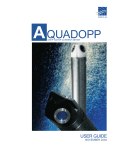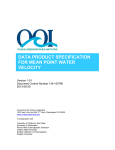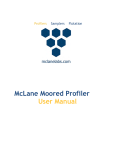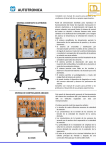Download August 2009 - Ocean Networks Canada
Transcript
Neptune OBS Operation Guide. Part No. MAN-OBS-0002 Designed and manufactured by Güralp Systems Limited 3 Midas House, Calleva Park Aldermaston RG7 8EA England Proprietary Notice: The information in this manual is proprietary to Güralp Systems Limited and may not be copied or distributed outside the approved recipient's organisation without the approval of Güralp Systems Limited. Güralp Systems Limited shall not be liable for technical or editorial errors or omissions made herein, nor for incidental or consequential damages resulting from the furnishing, performance, or usage of this material. Issue A 2009-08-21 MAN-OBS-0002 Table of Contents 1 2 Introduction......................................................................................................................................3 Operation Guide..............................................................................................................................4 Principals of operation................................................................................................................4 Power monitoring and control....................................................................................................4 2.2.1 Operation.....................................................................................................................4 2.2.2 Configuration...............................................................................................................8 2.3 Deployment...............................................................................................................................10 2.4 Recovery....................................................................................................................................17 2.1 2.2 3 3.1 3.2 Appendices.....................................................................................................................................20 Main Connector pin-out............................................................................................................20 Test harness pin-outs................................................................................................................22 3.2.1 Overview....................................................................................................................22 3.2.2 Aquadopp test connector..........................................................................................23 3.2.3 Differential Pressure Gauge test connector.............................................................24 3.2.4 Battery test connectors..............................................................................................25 3.2.5 Power Supply test connectors...................................................................................25 3.2.6 RS232 Data Out test connector.................................................................................26 3.2.7 Ethernet test connector.............................................................................................27 4 Revision history.............................................................................................................................28 2 Issue A Operation guide 1 Introduction Güralp Systems' “Neptune” Ocean Bottom System is a state-of-the-art multi-sensor unit comprising: • a CMG-5T triaxial true broadband feedback strong motion (±2g) accelerometer; • a CMG-1T triaxial true broadband (360s - 50Hz) feedback seismometer; • a CMG-DM24/7 24-bit, seven channel digitiser module; • a CMG-EAM enhanced acquisition and communications module; and • GSL's unique “Virtual Sphere” microprocessor-controlled orientation and levelling system all encased in a cast titanium sphere capable of withstanding immersion in up to 3,000 metres of water. A submersible 25-pin connector provides inputs for an external Nortek Aquadopp triaxial Doppler-effect current flow rate meter, an external differential pressure gauge, main 48V power and an auxiliary 12V back-up battery as well as data outputs via RS232 and TCP/IP Ethernet. The integrated CMG-EAM provides a single, easy-to-use, web-based interface for control, configuration and monitoring of all components. Sophisticated power-control electronics provide fine-grained monitoring and control of power consumption, minimising current requirements and maximising battery life. The CMG Neptune OBS embodies more than twenty years of experience in designing and deploying ocean-bottom seismometry systems in some of the harshest and most challenging environments on the planet. August 2009 3 MAN-OBS-0002 2 Operation Guide 2.1 Principals of operation The CMG Neptune OBS contains two seismometers, a CMG-5T strong motion triaxial accelerometer and a CMG-1T weak motion triaxial seismometer. Full details and specifications of the CMG-5T components are contained in Güralp manual MAN-050-0001, available for download from http://www.guralp.com/documents/MAN-050-0001.pdf. Full details and specifications of the CMG-1T components are contained in Güralp manual CMG-1OBS, available for download from http://www.guralp.com/support/manuals/pdf/1OBS.pdf. The outputs from these two systems, along with the output of the differential pressure gauge, are connected internally to a CMG-DM24/7 digitiser module. Full details and specifications for this module are contained in Güralp manual MAN-D24-0004, available for download from http://www.guralp.com/documents/MAN-D24-0004.pdf. The outputs from the CMG-DM24/7 and the Aquadopp flow meter are connected internally to an embedded CMG-EAM acquisition and communication module. Full details for this module are contained in Güralp manual MAN-EAM-0001, available for download from http://www.guralp.com/documents/MAN-EAM-0001.pdf. The EAM software has been extended to include functions specific to the CMG Neptune OBS. These are: • an enhanced power monitoring and control system; and • deployment and recovery sequence automation. These functions are described in the sections that follow. 2.2 Power monitoring and control 2.2.1 Operation The CMG Neptune OBS includes a power monitoring and control facility which can measure and switch the current flowing to and from the various components of the system. This can be accessed via the configuration interface of the CMG-EAM using a web browser. 4 Issue A Operation guide The configuration interface of the CMG-EAM is described in detail in MAN-EAM-0001. The following description assumes some familiarity with the use of this interface. To access the power monitoring and control facility, select “Digital I/O” from the Control menu: The following screen will appear: August 2009 5 MAN-OBS-0002 The screen is divided into sections, each dealing with a different current switch/measurement point, known as a “line”. Each line has a system name and a user name. User names can be configured individually (see Section 2.2.2 on page 8). For example, the first line displayed in the previous diagram has a system name of “Aux_power” and a user name of “Auxiliary (battery) power”. Next to the name of each line is displayed the line's status: low (off) or high (on). A line can be turned on and off with the “Set output low” and “Set output high” buttons. Note: the Neptune OBS systems are shipped with many power lines set low (turned off) in order to avoid unintentional battery drain. The default status of each line at powerup can be configured (see Section 2.2.2 on page 8). Below the status is displayed the measured voltage, current and power. The buttons marked “View details/settings” displays a screen similar to the following. The screen for Aux_power is used for illustration: 6 Issue A Operation guide Most of the features of this screen duplicate those on the main “Digital I/O” display. A “Refresh” button provides quicker access to the latest figures if a line is being monitored in real time. The two fields not present on the main “Digital I/O” display allow the configuration of under-voltage monitoring. If a voltage is typed into the “Lower voltage cut-off threshold” field and the “Set” button pressed, the system will cut power to the associated subsystem if the supply voltage falls below the figure entered. In order to prevent rapid switching when the supply power is very close to the threshold, a hysteresis value can also be entered. The supply voltage must rise to the sum of the threshold voltage and the hysteresis voltage before power to the associated subsystem is restored. The allocation of lines to hardware components for the CMG Neptune OBS is as follows: Line (system name) Function Data_Out Main 48V power feed (conditioned) Aux_power Auxiliary battery Port_A Power to embedded DM24/7 Sensor_power Power to CMG-1T sensor Ext0_power Power to CMG-5T sensor Ext1_power Power to D.P.G. Port_D Power to Aquadopp Note: both the incoming 48V power and the auxiliary battery power are both fed through a power conditioning circuit before being routed to the power control sensors, so it is the conditioned voltage that is monitored, not the supplied voltage. Note: The auxiliary battery will not be used unless the output for Aux_power is set high, in order to conserve battery life during shipping and deployment. The status of this line immediately after the unit boots can be configured: see Section 2.2.2 on page 8. August 2009 7 MAN-OBS-0002 2.2.2 Configuration To configure the user names of the power lines, select “All options” from the “Configuration” section of the main menu: From the resulting menu, select “GPIO labels and power switch settings. The following screen is displayed, from where it is possible to edit the user labels of the :power lines. Press the “Submit” button after making any changes. Below the GPIO labels configuration section, a number of drop-down menus allow you to configure the state (on or off) which each line will assume when the unit boots when power is first applied or after a power interruption. This part of the screen is shown overleaf. For each line, select the desired start-up state, then click the “Submit” button to save your changes. Note: no immediate changes to individual lines will be made as a result of using this feature. The settings only affect the lines after a reboot of the unit. 8 Issue A Operation guide Note: The auxiliary battery will not be used after the unit is rebooted unless the power-up state for Aux_power is set to “Power On”, in order to conserve battery life during shipping and deployment. The battery can still be turned on and off using the appropriate controls on the “I/ O Line Status” screen, as described in Section 2.2.1 on page 4. August 2009 9 MAN-OBS-0002 2.3 Deployment The CMG-EAM embedded in the Neptune OBS has a facility for automating the instrument deployment sequence, which involves checking the position of the OBS bowl (the internal, moveable instrument carrying platform) and, if it needs to be moved, locking the sensor masses (if not already locked) and then entering an iterative sequence of tilts, turns and orientation measurements until the bowl is precisely level. The instrument masses are then individually unlocked and centred. This whole sequence is triggered via controls within the configuration interface of the CMG-EAM, using a web browser. The configuration interface of the CMG-EAM is described in detail in MAN-EAM-0001. The following description assumes some familiarity with the use of this interface. To initiate the deployment sequence, choose the entry for the sensor from the “Control” menu (the name of this entry will change with the serial number of the component). Scroll down the resulting page to the section headed “Ocean Bottom Systems” The following screen is displayed: 10 Issue A Operation guide In normal use, only “Deploy” (described here) and “Recover” (described in Section 2.4 on page 17) will be required. Both of these run sequences of individual commands and it is possible to run any of these individual commands from this screen. The deployment sequence is: • Level - level the OBS bowl; • Align - Align the OBS bowl (to magnetic north); • Unlock OBS Components- unlock each sensor in turn; and • Centre OBS Components - centre each sensor masses in turn. The entire sequence can be run in the correct order by clicking the “Run” button in the “Deploy” box. This produces a large amount of diagnostic output to signify the progress of the operation. The bowl alignment procedure is iterative and several passes may be needed to achieve an acceptable attitude. Typical output is reproduced here, with explanatory notes in blue: August 2009 11 MAN-OBS-0002 Digitiser Control GSLA-1717 Deploy GSLA 171700 CMG1T2M Command Mode 0 blocks in buffer | 256 blocks free Guralp Systems Ltd - DM+FW v.106 mgs ok_1717 DEPLOY Deploy System? y/n ? y x-3 y-258 (the bowl is not Z Mass Locking.. lock the masses 0 249 Success Vertical Mass_Locked (Turned) Mass Position -102% N/S Mass Locking.. 7 249 Success North/South Mass_Locked (Not Turned ) Mass Position 102% E/W Mass Locking.. 10 249 Success East/West Mass_Locked (Not Turned ) Mass Position 102% 1 1 1 1 1 1 1 1 1 1 1 1 1 1 0 0 0 0 0 0 1 1 1 1 1 1 1 1 2 1 | Tilt |Rotate| 0 0 Y450 1 1 1 1 1 1 1 0 11 48 84 120 12 aligned, so we will before moving it) (these numbers show the current bowl tilt value...) 42 42 41 39 40 Limit Switch 39 40 40 40 41 41 42 17/08/09 (Build 33) 1 1 1 1 1 1 1 1 1 0 1 1 1 1 1now 1 1 1 1 1 1 1 1 1 1 0 1 0 1 1 1 1 1 1 1 1 1 TiltNull set 41 (...and these the rotation value) X | Y | -3 -260 << Bowl Datum x-3 y-258 x-4 (bowl now at datum and a new target orientation has been calculated) (bowl tilting) Issue A Operation guide 154 190 224 261 295 331 365 404 440 455 453 451 x-5 y249 T62 (bowl rotating) 0 1 5 10 12 16 18 this sequence will continue changing gradually. lines of output have been suppressed. | 59 60 60 60 60 60 60 61 Tilt |Rotate| 61 452 X | 51 Y | -20 x50 st y20 Several hundred R447 (1 approximation achieved, 2nd calculated) 451 451 449 446 x50 61 61 61 61 62 62 62 (bowl tilting) y19 T78 (bowl rotating) this sequence will continue changing gradually. lines of output have been suppressed. Several hundred 76 76 76 76 76 August 2009 13 MAN-OBS-0002 77 77 447 447 443 442 441 439 437 435 433 x50 77 77 434 433 431 430 428 426 424 422 419 x33 77 77 77 77 77 77 77 77 77 77 76 76 76 76 75 76 75 75 75 74 74 74 74 73 73 419 419 417 415 413 411 x20 14 447 y-50 433 y-53 420 y-32 63 44 x62 y-43 x62 y-43 R432 50 x49 y-50 x49 y-50 R419 35 x27 y-35 x27 y-35 R411 T77 50 T72 27 T71 Issue A Operation guide 73 74 73 73 72 72 411 411 409 407 405 x14 411 y-28 72 72 72 72 72 71 71 405 404 404 402 400 x8 y-24 71 72 71 70 71 70 70 70 70 69 68 69 400 400 400 397 x4 y-16 19 31 x18 y-31 x19 y-31 R404 27 x12 y-26 x11 y-26 R400 T70 12 T67 6 17 x5 y-17 x5 y-18 R397 T66 69 69 69 68 68 68 68 67 67 398 2 11 x2 y-12 x2 y-11 < Bowl Level SingleBowl System : Levelled (success) Z LOCKED N/S LOCKED E/W LOCKED | Tilt |Rotate| X | Y | 67 398 3 11 Z Mass UnLocking.. (now unlock the masses) 54 249 August 2009 15 MAN-OBS-0002 59 248 61 247 59 246 57 245 54 244 53 243 57 242 (the first number is the current 57 241 drawn by the locking motors, 56 240 the second a simple count-down 56 239 timer) 60 238 60 237 61 236 61 235 61 234 61 233 61 232 56 231 56 230 56 229 57 228 58 227 59 226 56 225 56 224 59 223 61 222 59 221 59 220 54 219 57 218 54 217 60 216 32 215 Success Z Mass Centring.. -85 59 Success Vertical Mass_Unlocked Centred Turned Mass Position -4% N/S Mass UnLocking.. 8 249 Success N/S Mass Centring.. 2047 59 1 1 1 1 1 1 1 1 128 -1 0 -1693 58 1 1 1 1 1 1 1 1 96 1 0 2047 57 1 1 1 1 1 1 1 1 72 -1 0 -1122 56 1 1 1 1 1 1 1 1 54 1 0 2047 55 1 1 1 1 1 1 1 1 40 -1 0 342 54 1 1 1 1 1 1 1 1 40 -2 0 -1582 53 1 1 1 1 1 1 1 1 30 1 0 -823 52 1 1 1 1 1 1 1 1 30 2 0 2047 51 1 1 1 1 1 1 1 1 22 -1 0 2047 50 1 1 1 1 1 1 1 1 22 -2 0 -4 49 Success North/South Mass_Unlocked Centred Not Turned Mass Position 0% 16 Issue A Operation guide E/W Mass UnLocking.. 10 249 Success E/W Mass Centring.. -772 59 1 1 1 1 1 1 1 1 128 1 0 2047 58 1 1 1 1 1 1 1 1 96 -1 0 -254 57 1 1 1 1 1 1 1 1 72 1 0 1379 56 1 1 1 1 1 1 1 1 54 -1 0 85 55 Success East/West Mass_Unlocked Centred Not Turned Mass Position 4% ok_1717 Command 'Deploy' run successfully Generated at 2009-08-18T11:19:11Z by digitiser-control.cgi 2.0.2 . Portions of output copyright (c)2009, Guralp Systems Ltd.. 2.4 Recovery The CMG-EAM embedded in the Neptune OBS has a facility for automating the instrument pre-recovery sequence, which involves locking the instrument masses prior to any potentially violent movements. This is accessed via the configuration interface of the CMG-EAM using a web browser. The configuration interface of the CMG-EAM is described in detail in MAN-EAM-0001. The following description assumes some familiarity with the use of this interface. To initiate the deployment sequence, choose the entry for the sensor from the “Control” menu (the name of this entry will change with the serial number of the component). August 2009 17 MAN-OBS-0002 Scroll down the resulting page to the section headed “Ocean Bottom Systems” The following screen is displayed: In normal use, only “Deploy” (described in section 2.3 on page 10) and “Recover” (described here) will be required. Both of these run sequences of individual commands and it is possible to run any of these individual commands from this screen. The recovery sequence is: • Lock OBS Components- lock each sensor in turn; and • Return to Datum - return the bowl leveller to the “home” position The entire sequence can be run in the correct order by clicking the “Run” button in the “Recover” box. This produces diagnostic output to signify the progress of the operation. Typical output is reproduced here, with explanatory notes. 18 Issue A Operation guide Digitiser Control GSLA-1717 Recover GSLA 171700 CMG1T2MCommand Mode 1 blocks in buffer | 255 blocks free Guralp Systems Ltd - DM+FW v.106 mgs 17/08/09 (Build 33) ok_1717 RECOVER Lock sensors for recovery? y/n ? y Z Mass Locking.. 86 249 Success Vertical Mass_Locked Turned Mass Position -102% N/S Mass Locking.. 82 249 Success North/South Mass_Locked Not Turned Mass Position 102% E/W Mass Locking.. 86 249 Success East/West Mass_Locked Not Turned Mass Position 102% 41 41 41 40 39 39 Limit Switch 39 39 40 40 41 41 41 | 1 1 1 1 1 1 1 1 1 1 1 1 1 1 0 0 0 0 0 0 1 1 1 1 1 1 1 1 1 Tilt |Rotate| -1 1 1 1 1 1 1 1 1 1 1 1 1 1 1 1 1 1 0 1 1 1 1 1now 1 1 1 1 1 1 1 1 1 1 0 1 0 1 1 1 1 1 1 1 1 1 TiltNull set 42 X | Y | -3 -258 ok_1717 Command 'Recover' run successfully Generated at 2009-08-18T11:19:11Z by digitiser-control.cgi 2.0.2 . Portions of output copyright (c)2009, Guralp Systems Ltd. August 2009 19 MAN-OBS-0002 3 Appendices 3.1 Main Connector pin-out This is a SEACON MIN-M-25-FSS 25-pin male connector. A suitable mating connector is provided. Additional connectors are available from Güralp Systems Ltd. or from Seacon directly at http://www.seaconbrantner.com/. The pin use is illustrated below and tabulated overleaf: 20 Issue A Operation guide Pin Function 1 EAM data ground 2 Aquadopp positive supply V+ 3 Aquadopp supply ground 4 Aquadopp power cable braid (shield) 5 DPG positive reference voltage +Vref 6 Aquadopp receive data 7 Aquadopp transmit data 8 Aquadopp data cable braid (shield) 9 DPG negative reference voltage -Vref 10 DPG + 11 EAM DATA OUT transmit data 12 EAM DATA OUT receive data 13 main power supply cable braid (shield) 14 battery supply cable braid (shield) 15 DPG reference voltage cable braid (shield) 16 DPG - 17 Ethernet Rx- 18 Ethernet Tx- 19 main power supply -ve 20 battery -ve 21 DPG signal? cable braid (shield) 22 Ethernet Rx+ 23 Ethernet Tx+ 24 Main power supply +ve 25 battery +ve Wiring details for the compatible socket, as seen from the cable end. August 2009 21 MAN-OBS-0002 3.2 Test harness pin-outs 3.2.1 Overview The test harness is shown below. Pin numbers in italics refer to the pins in the Seacon connector, as documented in Section 3.1 on page 20. The individual connectors are described in the following sections. 22 Issue A Operation guide 3.2.2 Aquadopp test connector These are standard DE9M (TIA-574) sub-miniature (D-sub) plugs, conforming to DIN 41652 and MIL-DTL-24308. They are very widely available, as are suitable mating connectors. Pin Function Associated Seacon pin 1 not connected 2 RS232 transmitted data* 7 3 RS232 received data* 6 4 not connected 5 Ground 6 not connected 7 not connected 8 Supply voltage +ve 9 not connected 2 4 *Note: The Aquadopp is considered the DTE and the Neptune OBS the DCE for this connection, so “transmitted” refers to data from the Aquadopp and “received” to data received by the Aquadopp. Note: the supply lines are shielded with the cable braid connected to pin 3 of the Seacon connector. Note: the data lines are shielded with the cable braid connected to pin 8 of the Seacon connector. Wiring details for the compatible socket, DE9F, as seen from the cable end. August 2009 23 MAN-OBS-0002 3.2.3 Differential Pressure Gauge test connector These are standard DE9F (TIA-574) sub-miniature (D-sub) line sockets, conforming to DIN 41652 and MIL-DTL-24308. They are very widely available, as are suitable mating connectors. Pin Function Associated Seacon pin 1 -DPG 16 2 - Vref 9 3 +DPG 10 4 +Vref 5 5 not connected 6 not connected 7 not connected 8 not connected 9 not connected Note: the '+' and '-' lines are shielded with the cable braid connected to pin 21 of the Seacon connector. Note: the reference lines are shielded with the cable braid connected to pin 15 of the Seacon connector. Wiring details for the compatible plug, DE9M, as seen from the cable end. 24 Issue A Operation guide 3.2.4 Battery test connectors These are standard 4mm “banana” plugs. They are very widely available, as are suitable mating connectors. Cable / Plug Function Associated Seacon pin Yellow / Red +ve 25 Green / Green -ve 20 Note: if the battery cable is shielded, the cable braid should be connected to pin 14 of the Seacon connector. 3.2.5 Power Supply test connectors These are standard 4mm “banana” plugs. They are very widely available, as are suitable mating connectors. Cable / Plug Function Associated Seacon pin Red / Red +ve 24 Green / Green -ve 19 Note: if the power supply cable is shielded, the cable braid should be connected to pin 13 of the Seacon connector. August 2009 25 MAN-OBS-0002 3.2.6 RS232 Data Out test connector This is a standard DE9F (TIA-574) sub-miniature (D-sub) line sockets, conforming to DIN 41652 and MIL-DTL-24308. They are very widely available, as are suitable mating connectors. Pin Function Associated Seacon pin 1 not connected 2 Transmitted data* 11 3 Received data* 13 4 not connected 5 Ground 6 not connected 7 not connected 8 not connected 9 not connected 1 Wiring details for the compatible plug, DE9M, as seen from the cable end. Note: The embedded CMG-EAM is considered to be the DTE for this connection, so “Transmitted” refers to data from the CMG-EAM and “Received” refers to data received by the CMG-EAM. 26 Issue A Operation guide 3.2.7 Ethernet test connector This is a standard 8P8C modular line jack, conforming to ANSI/TIA-968-A and IEC 60603. They are very widely available, as are suitable mating connectors. Pin Function Associated Seacon pin 1 Rx + 22 2 Rx - 17 3 Tx + 23 4 not connected 5 not connected 6 Tx - 7 not connected 8 not connected 18 Note: the connector is wired in “MDI” mode, which is suitable for connection to a hub, switch or router. In order to make a direct connection to, for example, a PC's network adaptor, it may be necessary to use a cross-over adaptor. Note: the colour-codes of the individual cable cores conform to TIA/EIA-568-B. Wiring details for the compatible socket, as seen from the back, e.g. when soldering. August 2009 27 MAN-OBS-0002 4 Revision history 2009-08-19 A 28 New Document Issue A





























